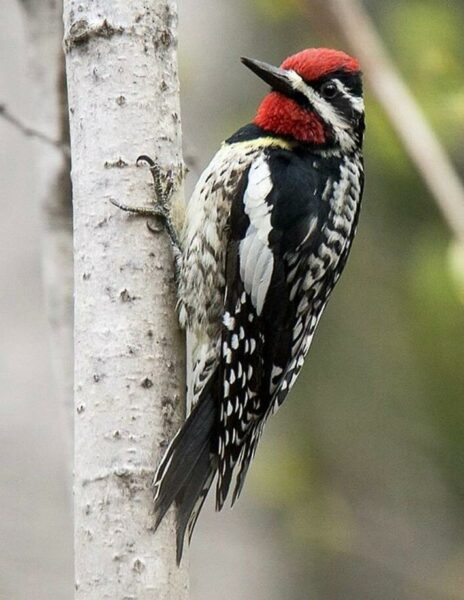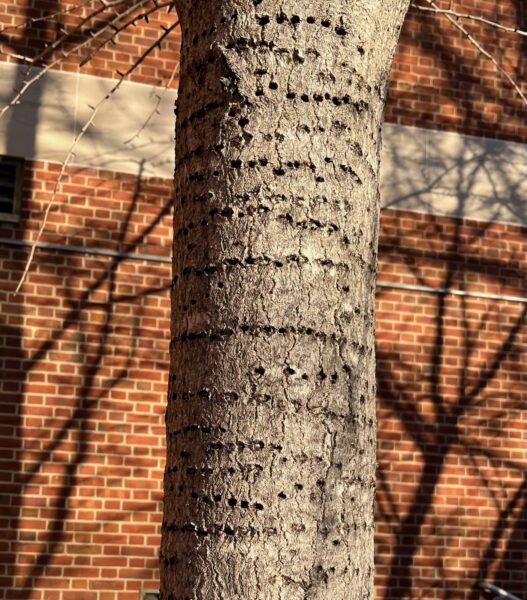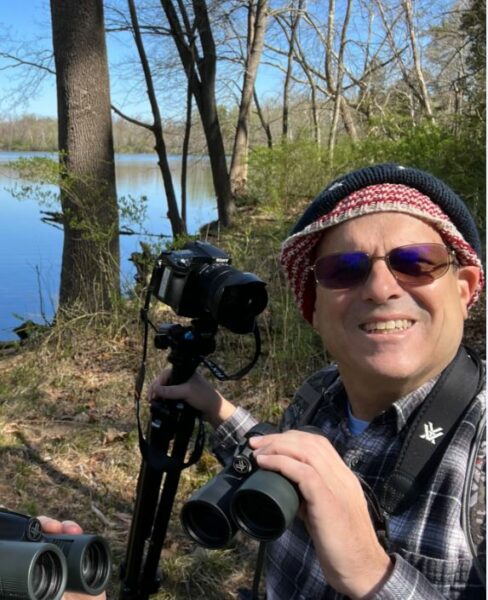by Adreon Hubbard
I didn’t used to think birdy thoughts on a regular basis. Like most people, I didn’t own a pair of good binoculars or know much about birds. After retiring, however, I signed up for a birding class, got a pair of excellent, yet affordable Vortex Diamondback 10 x 42 binoculars, and gained awareness, Matrix-style, of a new reality. Through numerous outings with instructor Marty Brazeau to local natural areas such as Loch Raven, Cromwell Valley, Oregon Ridge, Marshy Point, and with the help of free birding apps like the Cornell Lab of Ornithology’s Merlin Bird ID and eBird, I gradually learned how to spot and identify a variety of birds by their sounds, appearance, and behavior. Now I take binoculars with me on nearly every walk or trip, even on short jaunts in Overlook Park down the street or while strolling around our bird-friendly yard.
An interesting species I recently learned about is a lesser-known migratory woodpecker that winters in Maryland and further south, the comically-named Yellow-bellied Sapsucker (YBS.) Its pale yellow belly can be hard to see, because this bird is usually clinging vertically to a tree trunk, busily making horizontal rows of small holes called sapwells, then licking up the oozing sap with its brush-tipped tongue. YBS is the only woodpecker that makes horizontal rows of holes, which I have observed on a variety of local trees. The holes do not damage most trees unless they are already in decline, and a variety of insects and other wildlife feed on the oozing sap, including hummingbirds. Hummingbirds even time their migration north to take advantage of the sapwells’ sweet sustenance. Any insects going to the sap are typically eaten by the YBS as well, before they can harm the tree.
YBS can be harder to see than other woodpeckers due to its mottled feathers blending into the tree bark, and it is relatively quiet. It makes a distinctive mewing sound, however, which can alert you to its presence. Males have a red crown and throat, whereas females have only the red crown. Both have a distinctive white wing stripe and striped face. I recently spotted a pair of them perched on our backyard utility pole. “No sap there,” I thought. Perhaps they were after insects hiding in the many holes and crevices, or perhaps they were just resting and posing for me to enjoy!
Thankfully, YBS is one of only 39% of bird species globally that are not in decline. North American bird populations have plummeted by three billion birds in the last 50 years due to habitat loss, collisions with glass, predation by outdoor cats, and other factors. Only when we notice and appreciate birds can we begin to work to support their continued existence. I highly recommend giving birding a try!
Resources
Marty Brazeau’s April, 2024 Costa Rica birding tour may still have openings: https://www.youtube.com/watch?v=21IfZ2xz0L8
Email Marty at tropicbirder56@gmail.com for questions about the trip or upcoming CCBC birding classes.
Consider joining the Baltimore Bird Club to connect with birders and ongoing birding outings https://mdbirds.org/join/chapters/baltimore-bird-club/
Visit https://abcbirds.org/ to learn more about birds and threats to birds. This group has many excellent, free bird webinars on youtube.
My email is hubbardesol@gmail.com for any questions on supporting birds.
Adreon Hubbard is a member of Green Towson Alliance. Besides birding, she leads a group that removes invasive plants from Overlook Park in Towson. A version of this article originally appeared in the February 2024 Idlewylde Newsletter.



on a tree in Baltimore.

Photos of the Yellow-bellied sapsuckers, courtesy of All About Birds.
The photos of the tree and birding instructor were taken by Adreon Hubbard.
